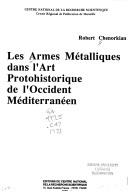| Listing 1 - 10 of 34 | << page >> |
Sort by
|
Book
Year: 1969 Publisher: München : Beck,
Abstract | Keywords | Export | Availability | Bookmark
 Loading...
Loading...Choose an application
- Reference Manager
- EndNote
- RefWorks (Direct export to RefWorks)
Book
ISBN: 9781785700187 1785700189 1785700189 Year: 2015 Publisher: Oxford : Oxbow Books,
Abstract | Keywords | Export | Availability | Bookmark
 Loading...
Loading...Choose an application
- Reference Manager
- EndNote
- RefWorks (Direct export to RefWorks)
For more than a century flint daggers have been among the most closely studied and most heavily published later prehistoric lithic tools. It is well established that they are found across Europe and beyond, and that many were widely circulated over many generation. Yet few researchers have attempted to discuss the entirety of the flint dagger phenomenon. The present volume brings together papers that address questions of the regional variability and socio-technical complexity of flint daggers and their production. It focuses on the typology, chronology, technology, functionality and meaning of flint and other lithic daggers produced primarily in Europe, but also in the Eastern Mediterranean and East Asia, in prehistory. The 14 papers by leading researchers provide a comprehensive overview of the state of knowledge concerning various flint dagger corpora as well as potential avenues for the development of a researcher agenda across national, regional and disciplinary boundaries.
Weapons, Prehistoric --- Daggers --- Stone age --- Europe
Book
Year: 1899 Publisher: Washington, : Gov't Print. Off.,
Abstract | Keywords | Export | Availability | Bookmark
 Loading...
Loading...Choose an application
- Reference Manager
- EndNote
- RefWorks (Direct export to RefWorks)
Arrowheads. --- Spears. --- Stone age. --- Weapons, Prehistoric.
Book
ISBN: 3774932379 Year: 2004 Publisher: Bonn : Habelt,
Abstract | Keywords | Export | Availability | Bookmark
 Loading...
Loading...Choose an application
- Reference Manager
- EndNote
- RefWorks (Direct export to RefWorks)
Bronze age --- Bronze age --- Excavations (Archaeology) --- Excavations (Archaeology) --- Swords, Prehistoric --- Swords, Prehistoric --- Weapons, Prehistoric --- Weapons, Prehistoric
Book

ISBN: 9782364791565 2364791561 Year: 2023 Publisher: Dijon 01-Perronas APRAB impr. SEPEC.
Abstract | Keywords | Export | Availability | Bookmark
 Loading...
Loading...Choose an application
- Reference Manager
- EndNote
- RefWorks (Direct export to RefWorks)
Guerre, violence, opportuniste ou ritualisée, crispation territoriale, expression de la force et du pouvoir sont des notions fréquemment mises en avant pour caractériser l'âge du Bronze, époque marquée par une accélération des processus de hiérarchisation des sociétés. À travers quatre sessions, l'objectif de ce colloque sera de discuter ces considérations à partir de sources relatives à l'organisation, individuelle ou collective, technique ou symbolique, des manifestations de violence et de guerre.
Bronze age --- Bronze age --- Weapons, Prehistoric --- Weapons, Prehistoric --- Fortification, Prehistoric --- Fortification, Prehistoric
Book
Year: 1969 Volume: 1 Publisher: München : Beck,
Abstract | Keywords | Export | Availability | Bookmark
 Loading...
Loading...Choose an application
- Reference Manager
- EndNote
- RefWorks (Direct export to RefWorks)
Bronze age --- Weapons, Prehistoric --- Age du bronze --- Armes préhistoriques

ISBN: 2222041430 Year: 1988 Publisher: Paris : Editions du Centre national de la recherche scientifique : Presses du CNRS, diffusion,
Abstract | Keywords | Export | Availability | Bookmark
 Loading...
Loading...Choose an application
- Reference Manager
- EndNote
- RefWorks (Direct export to RefWorks)
Weapons, Prehistoric --- Bronze age --- Armes préhistoriques --- Age du Bronze
Book
ISBN: 3515119817 9783515119818 Year: 2018 Publisher: Stuttgart : Franz Steiner Verlag,
Abstract | Keywords | Export | Availability | Bookmark
 Loading...
Loading...Choose an application
- Reference Manager
- EndNote
- RefWorks (Direct export to RefWorks)
In jüngster Zeit erlangen Untersuchungen zur Herstellung von Bronzeobjekten besondere Bedeutung. Der Band dokumentiert aus einem zentralen Kulturbereich Mitteleuropas alle in West- und Süddeutschland gefundenen Gie�formen aus Keramik, Metall und Stein und diskutiert ausführlich Funktionsweise, Zeitstellung und Verbreitung sowie ihren jeweiligen Fundkontext (Siedlungen, Hortfunde, Grabfunde). Es konnten für das Arbeitsgebiet ca. 170 Gie�formen erfasst werden. Überlieferungsbedingt bestehen sie hauptsächlich aus Stein, gefolgt von Metall (Bronze) und, sehr selten, von Formen aus Keramik. Die materialbedingten Gie�eigenschaften werden eingehend erörtert. Im Fokus stehen die unterschiedlichen Gesteinsarten, die für Gie�formen verwendet wurden.0Die Studie schlie�t eine gro�e Lücke in der Vorlage der Gie�formen in Europa und erörtert für die in der Reihe Prähistorische Bronzefunde zahlreich edierten Fundgruppen aus Süd- und Westdeutschland die herstellungstechnischen Grundlagen. Der Band enthält einen Katalog- und Abbildungsteil mit 70 Tafeln. In einem Zusatzbeitrag untersucht Albrecht Jockenhövel in einem gesamteuropäischen Kontext Gräber mit archäometallurgischen Objekten.
Bronzes, Prehistoric --- Pottery molds --- Weapons, Prehistoric --- Casts --- Molding materials --- Bronze founding --- History --- Germany --- Antiquities --- Bronze age
Book
ISBN: 9781407359441 Year: 2022 Publisher: Oxford : BAR Publishing,
Abstract | Keywords | Export | Availability | Bookmark
 Loading...
Loading...Choose an application
- Reference Manager
- EndNote
- RefWorks (Direct export to RefWorks)
Military weapons --- Military archaeology --- Weapons, Ancient --- Weapons, Prehistoric. --- Soldiers --- Military art and science --- History. --- Social aspects
Book
Year: 1938 Volume: 11 Publisher: Berlin : Walter de Gruyter & co.,
Abstract | Keywords | Export | Availability | Bookmark
 Loading...
Loading...Choose an application
- Reference Manager
- EndNote
- RefWorks (Direct export to RefWorks)
Daggers, Prehistoric --- Weapons, Prehistoric --- Bronze age --- Poignards préhistoriques --- Armes préhistoriques --- Age du bronze
| Listing 1 - 10 of 34 | << page >> |
Sort by
|

 Search
Search Feedback
Feedback About UniCat
About UniCat  Help
Help News
News